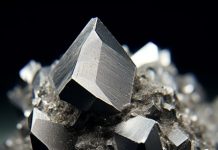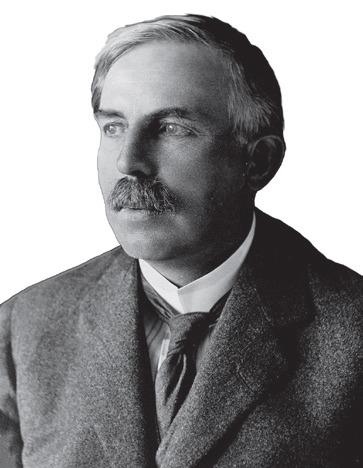Sir Ernest Rutherford (1871–1937)
The Founder of Nuclear Science
A passionate, indefatigable researcher, Sir Ernest Rutherford is acknowledged to have initiated the era of big science around the dawn of the 20th century. His remarkable discoveries of the concept of radioactive half-life, of the alpha and beta particles, the atomic nucleus, and the proton inspired many more scientists such as Niels Bohr to carry out further research in atomic science. But it was his ground-breaking discovery, that an atom is mostly empty space and that almost all of its mass was concentrated in a tiny nucleus at the centre, that set the stage for the commencement of nuclear physics and nuclear chemistry.
Rutherford’s extensive body of research won him so many awards, it is believed that his collection of medals is the largest ever awarded to any one scientist. Quite rightly, one of his recent biographers, John Campbell, paid him the ultimate tribute referring to him as the ‘Scientist Supreme’, even going on to add: He (Rutherford) is to the atom what Darwin is to evolution, Newton to mechanics, Faraday to electricity, and Einstein to relativity.
The celebrated scientist Sir J. J. Thomson, discoverer of the first subatomic particle – the electron, and winner of the Nobel Prize in Physics in 1906, mentored Rutherford as a postgraduate student from 1895 to 1898. Greatly impressed by his new student, not by his height, athletic built, and vivid blue eyes, but his potential for scientific work, he said, “I have never had a student with more enthusiasm or ability for original research than Mr. Rutherford.”
The Nobel Prize in Chemistry that Rutherford was awarded in 1908 for “his investigations into the disintegration of the elements, and the chemistry of radioactive substances” was a recognition of the significance of his scientific work and his stature as an exceptional researcher. Not just that, Rutherford’s boundless enthusiasm for original research was so inspiring that an astonishingly large number of scientists who carried out research under his guidance or alongside him, namely, James Chadwick, Cecil Powell, Niels Bohr, Otto Hahn, Frederick Soddy, John Cockcroft, Ernest Walton and Edward Appleton went on to become Nobel Prize winners too.
Early Life
Ernest Rutherford was born on 30 August 1971 in rural Spring Grove (now called Brightwater), not far from the town of Nelson in New Zealand’s South Island. The fourth child of James Rutherford, a farmer, and Martha Thompson, a teacher, he was one of 12 children. His mother believed ‘all knowledge is power’, and so, despite money being tight, she and Rutherford’s dad made sure all their children were well educated.
Rutherford had a hard life as a boy and is known to have famously said that his inclination towards innovative research sprang from having had to find inventive ways of living with limited resources in a poor family. He said as a child he used to tell himself, “We haven’t got the money, so we’ve got to think.”
Having earned a scholarship in 1890 to study at the University of New Zealand’s Canterbury College in Christchurch, Rutherford graduated with three degrees in four years. A B.A. in pure mathematics and Latin (both compulsory subjects), applied mathematics, English, French, and physics in 1892; an M.A. with double first-class honours in mathematics and mathematical physics, and also in physical science (electricity and magnetism) in 1893; and just one year later, on the strength of the independent research he carried out on the ability of high-frequency electrical discharge to magnetize iron, he got his Bachelor of Science degree in chemistry and geology.
In 1895, Rutherford won another scholarship to pursue postgraduate studies in the UK. At 24, armed with his three degrees, he joined the University of Cambridge where he began studying and researching at the Cavendish Laboratory headed by J. J. Thomson. He was the first non-Cambridge research student to study there.
Revolutionary scientific contributions
Thomson was tremendously taken up by the kind of advanced research Rutherford was capable of at a young age. So, in 1902, when Montreal’s McGill University was looking for a new Chair of Physics, he recommended Rutherford for that position. Rutherford was just 27 when he sailed to Canada to accept the professorship at McGill. It was here that he carried out the research that won him the Nobel Prize – research on the radiations emitted when radioactive elements decayed. But by the time he got the award in 1908, he had already moved back to the UK where he was appointed as the Chair of Physics of the University of Manchester.
Rutherford made his most important discovery after being awarded the Nobel Prize. The University of Manchester was where, under his guidance, his researchers Hans Geiger and Ernest Marsden carried out the famous gold foil experiment. The astonishing results of this experiment led to Rutherford’s discovery of the atomic nucleus in 1910, and to his nuclear model of the atom replacing J. J. Thomson’s earlier plum pudding model.
In 1912, fascinated by Rutherford’s discovery, Niels Bohr, then a young 26-year old researcher joined his laboratory in Manchester as a research student. Bohr adapted Rutherford’s atomic model to Max Plank’s quantum theory, resulting in the first quantum model of the atom – the Rutherford-Bohr atom. After that, Rutherford and Bohr became close friends and in later years often spent vacations together along with their wives.
Continuing with his experiments in atomic science, a few years later, in 1917, when Rutherford bombarded nitrogen atoms with alpha particles and converted them into oxygen atoms, he not only became the first scientist to split the atom, he also turned out to be the world’s first successful alchemist. The results of this research were published in 1919. That same year, things came full circle for him when he moved back to the Cavendish Laboratory at Cambridge where he had first started his research work in the UK with J. J. Thomson as his mentor. Only, this time he was there to be made the Director of the Laboratory and its Professor of Physics following the retirement of Sir J. J. Thomson.
Awards and honours
Rutherford was awarded numerous prestigious medals, prizes, honorary degrees and doctorates from different countries, in addition to fellowships of reputed societies and organisations. He was also the President of the Royal Society. He continued to be honoured even after his sudden death in 1937. Several countries including New Zealand, the UK, Sweden, and Canada issued postage stamps in his honour, and buildings and institutions in different parts of the world were named after him. In 1969, element 104 was named rutherfordium as a tribute to him. In 1991, the Rutherford Origin, an attractively set up outdoor display of Rutherford’s life and scientific work built on the site of his birth was opened in the presence of his grandchildren. In 1992, New Zealand issued a new $100 banknote featuring his portrait.
Rutherford was knighted in 1914, and given the title of Sir Ernest Rutherford. In 1925, he was appointed to the Order of Merit. When he visited New Zealand that year to deliver public lectures and visit his aged parents, he was felicitated as an illustrious New Zealander. People packed the halls where he delivered lectures on the structure of the atom.
But this also turned out to be his last visit to his home country. He died unexpectedly in Cambridge on October 19, 1937 at the age of 66 following surgical complications. A small delay in being operated upon for a partially strangulated umbilical hernia could possibly have led to his untimely death.
Rutherford’s ashes were interred in the nave of Westminster Abbey close to the tombs of Sir Isaac Newton and Lord Kelvin. Three years later, the remains of his mentor, Sir J. J. Thomson were buried next to him.
References
- NobelPrize.org: Ernest Rutherford – Biographical – Nobel Media AB 2014, http://www.nobelprize.org/nobel_prizes/chemistry/laureates/1908/rutherford-bio.html
- Famous Scientists: Ernest Rutherford – www.famousscientists.org/ernest-rutherford
- John Campbell: Rutherford – A Brief Biography – The World and I magazine, June 2011
- John Campbell: Rutherford, Ernest – Encyclopaedia of New Zealand, https://teara.govt.nz/en/biographies/3r37/rutherford-ernest
- New Zealand History: Ernest Rutherford Biography – https://nzhistory.govt.nz/people/ernest-rutherford
- Biography.com: Ernest Rutherford – Physicist, Scientist (1871 – 1937) – https://www.biography.com/people/ernest-rutherford-39099
































